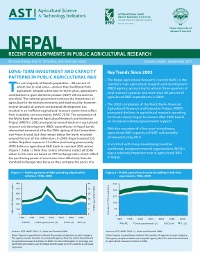Authors:
Rahija, Michael; Shrestha, Hari K.; Stads, Gert-Jan
Year:
2011
Publisher
International Food Policy Research Institute (IFPRI); and Nepal Agricultural Research Council (NARC)
Back to:
The 2002 completion of AREP, a World Bank–financed project, led to a sharp decline in Nepal’s agricultural R&D investment levels. Although spending rebounded somewhat during 2003–09, total agricultural R&D expenditures remain below the levels recorded around the turn of the millennium. In 2009, the country invested 520 million Nepalese rupees or 23 million PPP dollars in agricultural R&D (both in constant 2005 prices), or just 0.24 percent of its AgGDP that year. The country’s total number of agricultural researchers has also declined over time, largely due to the combined efect of a long-term hiring freeze and the loss of scientists seeking better opportunities abroad. Years of no recruitment have left NARC with a rapidly aging pool of scientists and numerous vacant positions.
Despite past and present challenges, the Government of Nepal recognizes the importance of agricultural R&D for the nation’s development, as highlighted in a number of important policy documents, but instability at the ministerial level continues to pose a major challenge. The government has prioritized agricultural R&D by committing to increase its contributions to NARC by 10 to 20 percent per year, and preliminary data indicate progress in this regard. In addition, NARC has recruited 70 BSc-level scientists since 2010, easing some of its acute capacity challenges. Training and mentoring of these newly recruited scientists will be a major priority in the coming years, as a signiicant proportion of NARC’s senior scientists are approaching retirement age.
Five years after the signing of the Comprehensive Peace Accord, Nepal’s political climate remains fragile. Both MoAC and MOST lack the power, capacity, and continuity to set the country’s long-term agricultural R&D agenda and to ensure that suicient resources are available for research. The country needs to put efective and eicient policy implementing bodies and instruments for agricultural R&D in place if it is to succeed in enhancing smallholder production, cutting (rural) poverty, and competing in a global market.

